Heinz-Steyer-Stadion – until 2021
| Capacity | 4 500 |
|---|---|
| Country | Germany |
| City | Dresden |
| Clubs | Dresdner SC, Dresden Monarchs |
| Retire year | 2021 |
| Other names | DSC-Stadion im Sportpark Ostragehege (1919–1945), Stadion im Sportpark Ostragehege (1945–1949) |
| Inauguration | 12/10/1919 |
| Construction | 1918–1919 |
| Renovations | 1929, 1930, 1971–1972, 2015–2017 |
| Cost | M 181,000 ($20,000) |
| Record attendance | 62,150 (Germany – Czechoslovakia 2–1, 26/05/1935) |
| Address | Pieschener Allee 1, 01067 Dresden-Friedrichstadt |
Advertisement
Heinz-Steyer-Stadion – historical stadium description
What’s a brief overview of the Heinz-Steyer-Stadion before its 2021–2024 reconstruction?
The stadium, built independently by Dresdner SC, was inaugurated on 12 October 1919. Located not far from Dresden’s historic city centre, it had an unusual “neighbour” – an oriental-style building known as Yenidze, whose distinctive dome became a permanent feature of the stadium’s surroundings.
Dresdner SC achieved its greatest sporting success... during World War II. The club first became German vice-champions (1939/40), and then went on to win the national championship in the final two seasons before league play was suspended (1942/43 and 1943/44).
After the war, the new communist authorities nationalised the club’s assets and dissolved Dresdner SC. The team was soon re-established under the new name SG Friedrichstadt. However, this team was also disbanded shortly afterwards, following a scandal during the decisive match for the first East German championship at the end of the 1949/50 season.
Subsequent tenants included clubs such as Dynamo (which won the East German title in 1953 while playing at this stadium), Einheit, and Lokomotive. After the fall of the Berlin Wall, a “new” Dresdner SC was founded, referring back to the legacy of the original club – though without matching its past sporting success.
Since 1949, the stadium has been named after Heinz Steyer – a communist activist, footballer, and victim of the Nazi regime. That same year, floodlights were installed for the first time, once (mistakenly) considered the first of their kind in Germany.
The Heinz-Steyer-Stadion was one of the two main stadiums in Dresden, alongside the Rudolf-Harbig-Stadion, which gradually took on a more prestigious role during the GDR era.
The venue played a significant role in athletics – numerous world records were set here, including an unofficial one... in running backwards (10 km). It also hosted international matches featuring the national teams of both Germany and East Germany, East German Cup finals, the 1949 “Ostzone” championship match, a performance by the Alexandrov Choir, and stage finishes of the Peace Race cycling event.
The stadium was not spared from disasters. In 1945 it was hit by an Allied bomb, and in the early 21st century it faced major floods. Its stands were also damaged by fire on two separate occasions, and during the major reconstruction, someone stole and destroyed the commemorative plaque listing world records set at the venue.
Between 2015 and 2017, a new stand was built on the northern side. A decision was then made to completely redevelop the stadium, with the newly built north stand being the only major structure preserved. The full-scale reconstruction took place between 2021 and 2024, and the “new” Heinz-Steyer-Stadion was officially inaugurated on 30 August 2024.
What did the Heinz-Steyer-Stadion originally look like?
The new stadium featured a 420-meter running track and, on its southern side, a covered stand 42 meters long and 8 meters tall, offering seating for 500 spectators. Including standing space around the track, the overall capacity was estimated at 20,000.
The facility was built in the area known as Ostragehege, on part of a meadow called Schmelzwiese, which local residents had used for leisure and sporting activities. The first recorded cricket match there dates back to 1863. After Dresdner SC was founded in 1898, the club also used the site for training. However, in 1899 the authorities banned them from playing there, as footballers were disturbing people taking walks.
The stadium was intended to be the centerpiece, but not the only facility, in a larger sports complex planned by Dresdner SC. During the 1920s, additional facilities were added, and by 1932 the club had eight sports venues within the complex, including a hockey field and tennis courts.
Next to the stadium, the Jewish club Bar-Kochba also built its own ground, inaugurated on October 14, 1928. After the Nazis came to power in 1933, the lease for the land was revoked, and the Bar-Kochba stadium was handed over to ATV Dresden, who rebuilt it in 1935–1936. After the war, the facility ceased to exist.
What was the fate of the Heinz-Steyer-Stadion during the interwar period?
The Dresdner SC stadium was hit by two floods in its early years, in 1920 and 1923. In 1924, the main stand received a steel roof. Just a year later, it was replaced by a new wooden stand with 1,560 seats.
On the night of October 17–18, 1928, the newly built wooden stand was completely destroyed by fire. A new brick stand with an attached clubhouse was quickly erected in its place – construction began on August 7, 1929, and the opening took place on November 24 of the same year.
The club allocated 150,000 marks for the construction, and the new stand was designed by Konrad Materne. To mark the occasion, Dresdner SC hosted reigning German champions SpVgg Fürth, losing 0–3 in front of 20,000 spectators.
In 1930, a new wooden stand for 2,200 spectators was erected on the north side, opposite the main stand. It opened on August 31, 1930, during a match against 1. FC Nürnberg. The real test, however, came just under a month later, during the international fixture between Germany and Hungary on September 28, 1930 (5–3).
With terraced stands surrounding the running track, the stadium’s capacity already exceeded 60,000. The all-time attendance record was set on May 26, 1935, when Germany played Czechoslovakia (2–1) in front of 62,150 spectators.
On April 30, 1938, when Dresdner SC celebrated its 40th anniversary, the club was granted a 99-year lease on the land that housed its stadium and sports complex.
How was the Heinz-Steyer-Stadion affected at the end of World War II?
During the Allied bombing of Dresden in February 1945, bomber pilots used the stadium as a navigation landmark. On February 13, it was hit by a target marker bomb, which landed on the eastern curve of the stands. However, the damage was not severe compared to the enormous destruction the city suffered during the raids of February 13–15.
What is the history of Heinz-Steyer-Stadion in the first years after World War II?
After the war, the property of Dresdner SC was nationalized, and the stadium was declared public property. The facility was rebuilt from wartime damage thanks to the work of athletes and city residents, supported by a state grant of 500,000 marks.
On August 25, 1946, the stadium hosted a match between representative teams of the cities (Dresden – Berlin, 6–2), attended by 60,000 spectators.
When was the stadium in Ostragehege named after Heinz Steyer?
On June 21, 1949 (a few days before the final of the Soviet occupation zone championship held at the venue), the stadium was named after Heinz Steyer – a Dresden-born communist, labor sports activist, and footballer who was executed by the Nazis in 1944 for his involvement in the resistance. In addition to naming the stadium in his honor, a commemorative obelisk was erected in front of the main stand.
After the fall of communism, there were calls to rename the stadium after a more fitting figure: Helmut Schön, former Dresdner SC player who later, as head coach of the West Germany national team, won the World Cup in 1974. However, the name was never changed. Instead, after the 2021–2024 reconstruction, one of the seats in the main stand was designated as the Helmut Schön honorary seat (Helmut-Schön-Ehrensitz).
When was floodlighting inaugurated at Heinz-Steyer-Stadion?
On December 31, 1949, floodlighting was inaugurated at the stadium, consisting of 12 masts equipped with mounted lamps. It is often claimed that this was the first stadium floodlighting in Germany, although a match under artificial light had already taken place in Hanover in 1926.
The inauguration coincided with a match between SG Friedrichstadt (an unofficial successor of Dresdner SC) and the East Germany national team (2–0), which also served as the farewell match of legendary striker “King” Richard Hofmann. During the match, fans lit 30,000 candles to “assist” the new floodlights.
What happened to Heinz-Steyer-Stadion in the following years?
In 1951, another fire broke out, damaging the wooden stand on the north side. The damage was repaired the following year. In 1963, a sound system was installed.
Between 1971 and 1972, the stadium underwent another modernization, primarily to meet the needs of athletics competitions. The inner oval was widened by removing the front rows of stands, creating space for a modern tartan running track.
A marathon gate was built on the eastern curve for runners and participants of the Peace Race. The renovated stadium was inaugurated on July 12, 1972, with the Heinz Steyer Memorial athletics meeting.
The installation of the tartan track contributed to a veritable “boom” in world records, with 12 set (including one equaled) at the stadium over the next few years until 1979.
What is the history of the electronic scoreboard at Heinz-Steyer-Stadion?
In 1978, an electronic scoreboard was installed on the western curve, produced by the Hungarian company Elektroimpex. The large rectangular structure measured 17.2 × 8.28 meters.
The main display consisted of 260 dot matrices (arranged 26 horizontally × 10 vertically), each containing 35 light points (7×5), capable of displaying one letter, digit, or special character.
In the upper left corner, there was a 2-meter diameter analog clock. Below the clock, an additional 14 dot matrices were placed. Altogether, the board had about 10,000 light points, using 50-volt bulbs.
The display was remotely controlled from a small room in the main stand, using a system based on perforated tape. Over the years, it showed sports results, including world records set at the stadium.
The special 50-volt bulbs became increasingly difficult to obtain during the GDR era and practically unavailable after the fall of communism, making it impossible to replace worn-out bulbs. As a result, individual matrices were gradually taken out of use.
The scoreboard operated regularly until the 2004/05 season and was last activated in 2007. Initially, the distinctive scoreboard was planned to be preserved when the stadium reconstruction began in 2021, but ultimately it was dismantled in June 2022.
The scoreboard’s successor at the rebuilt Heinz-Steyer-Stadion is a modern LED screen, installed above the northern stand in July 2025.
Could Heinz-Steyer-Stadion have become a venue for the 2006 World Cup?
At the end of the 20th century, there were plans to build a new football stadium on the site of the existing Heinz-Steyer-Stadion for the 2006 World Cup. However, these plans proved unrealistic due to lack of funding, and Dresden was removed by the DFB from the list of candidate cities in spring 1999, even before Germany was officially chosen as the tournament host.
A modern football stadium was eventually built in Dresden between 2007 and 2009, but as part of the reconstruction of another venue – Rudolf-Harbig-Stadion.
What were the effects of the early 21st-century floods on Heinz-Steyer-Stadion?
In August 2002, during a catastrophic flood, the stadium was submerged and suffered significant damage. Due to heavy rainfall in the Elbe basin, the water level in Dresden reached a record 9.40 meters – higher than during the historic 1845 flood.
Flooded rooms under the main stand required extensive renovation, and the wooden northern stand was completely closed.
Another flood hit Dresden nearly four years later, in late March and early April 2006, when the Elbe level reached about 7.50 meters. This time, thanks to preventive measures, the stadium was protected from flooding. The floodwaters were literally stopped at its gates – a sandbag levee placed at the marathon gate successfully prevented water from entering.
Between 2008 and 2009, as part of large-scale flood protection investments by the city, solid walls were built around the eastern curve and the northern stand, serving as a flood barrier.
The next flood occurred in January 2011, with water levels reaching about 6 meters. Thanks to experience from previous floods, a steel barrier was installed at the marathon gate, effectively preventing water from entering the stadium area.
The steel barrier and flood wall also protected the stadium in June 2013, during another major flood when the Elbe level reached 8.76 meters.
When was the new north stand at Heinz-Steyer-Stadion built?
As the technical condition of the stadium deteriorated, more and more sections were closed off, reducing capacity to just 4,500 spectators.
On March 16, 2015, reconstruction began on the closed-off north stand, which was completely demolished, including its distinctive wooden superstructure. In its place, a new fully-roofed reinforced concrete stand with 1,864 seats was built at a cost of around €4 million. The new stand was officially opened on August 4, 2017.
Before the stand was rebuilt, a two-storey building with changing rooms, restrooms, and other facilities was constructed behind the north-west corner of the stadium. This part of the investment cost €1.6 million.
When did Heinz-Steyer-Stadion undergo a major redevelopment?
How did the redevelopment of Heinz-Steyer-Stadion come about?
Following the completion of the new north stand, the city decided to continue investing in the stadium. On June 28, 2018, the city authorities announced plans for a full-scale redevelopment of the facility. A preliminary feasibility study was prepared by the municipal company STESAD GmbH.
When was the general contractor for the redevelopment of Heinz-Steyer-Stadion selected?
On July 1, 2019, a competitive dialogue process was launched to select the general contractor. Three candidates participated: the Düsseldorf-based BAM consortium, Ed. Züblin AG from Stuttgart, and Austrian firm HABAU.
On November 17, 2020, the offer submitted by the BAM consortium was selected as the best. The design for the redevelopment was prepared by O+M Architekten in collaboration with phase10. On January 28, 2021, the City Council unanimously approved the project, and the contract with BAM Sports GmbH (which became ZECH Group in October 2021) was signed on February 15, 2021.
When was the redevelopment of Heinz-Steyer-Stadion carried out?
On October 26, 2021, Mayor Dirk Hilbert inaugurated the redevelopment, which began with the demolition of the old main stand. Work on the foundations for the new main stand began between February and March 2022. The cornerstone laying ceremony and time capsule burial took place on June 2, 2022.
On April 4, 2023, a topping-out ceremony was held, symbolically marking the structural completion of the new south stand. The event was attended by Mayor Dirk Hilbert, representatives from the worlds of sport and politics, and those involved in the project.
In April 2024, a new running track was laid, and in May 2024, photovoltaic panels were installed on the roof of the main stand. The venue was completed by the end of June and was officially handed over to the city on July 1, 2024. The total cost of the redevelopment was approximately €54 million.
When was the rebuilt Heinz-Steyer-Stadion inaugurated?
The refurbished stadium was inaugurated on August 30, 2024. The grand opening was marked by the 7th edition of the revived Goldenes Oval athletics meeting, held in front of a full crowd.
One day earlier, a 5 km Stadium Run took place, linking Dresden’s two main stadiums. The race began at Rudolf-Harbig-Stadion and finished at Heinz-Steyer-Stadion.
What did the Heinz-Steyer-Stadion renovation between 2021 and 2024 include?
During the works carried out between 2021 and 2024, the stadium underwent a thorough reconstruction. The relatively new northern stand, built between 2015 and 2017, was retained from the old stadium. The main stand, equipped with extensive facilities, was built entirely from scratch, and the stands on the curves were also rebuilt.
A ring-shaped steel structure with mounted floodlights was erected around the venue, which also serves an aesthetic function, visually uniting the entire building. An approximately 115-meter-long truss, stretching over the roof of the northern stand, is part of this structure.
The scoreboard, which had been out of use since 2007, was removed – replaced by a new LED screen installed above the northern stand after the reconstruction was completed, in July 2025. After modernization, the venue can accommodate 10,343 spectators, of which 5,400 seats are covered.
The "new" Heinz-Steyer-Stadion after the 2021–2024 renovation is presented on a separate subpage
What events took place at Heinz-Steyer-Stadion until 2021?
Who was the host of Heinz-Steyer-Stadion?
1919–1945: Dresdner SC
The stadium was built between 1918 and 1919 through the efforts of Dresdner SC, which was initially the owner and main user of the venue. In 1938, on the club’s 40th anniversary, Dresdner SC was granted a 99-year lease of the land on which the stadium stood.
The Dresdner SC football team, especially during World War II, was among the top German clubs. Many well-known players of the time played for the team, such as Helmut Schön (later the coach of West Germany’s national team, with which he won the 1974 World Cup), Richard Hofmann, and goalkeeper Willibald Kreß.
The team’s greatest success was winning the German championship twice during World War II — in the last two full seasons before the suspension of competitions (1943 and 1944). In 1940, they also finished as runners-up.
Dresdner SC won the German Cup twice as well, then called the Tschammerpokal (Tschammer Cup) — in 1940 and 1941. Additionally, in 1941, Dresdner SC defeated Schalke 04 in the so-called Herausforderungskampf, a match now regarded as an unofficial precursor of the German Supercup.
The club also performed very well in regional league competitions, whose winners qualified for the national championships. Dresdner SC were Central German champions in 1905, 1926, 1929, 1930, 1931, and 1933, and after the introduction of the Gauliga, they won the Gauliga Sachsen in 1934, 1939, 1940, 1941, 1943, and 1944.
Dresdner SC also won the Central German Cup twice, in 1928 and 1933.
1945–1990: GDR era
After the war, Dresdner SC was dissolved, but a successor team, SG Friedrichstadt, was formed, consisting mostly of players from the former DSC. In 1949, the team took part in the Soviet occupation zone championship (Ostzonenmeisterschaft), where they were eliminated in the quarter-finals after a 1–2 defeat to ZSG Union Halle.
SG Friedrichstadt then joined the inaugural season of the GDR league (1949/50). The team was among the top contenders and battled for the title until the last round of the season, but lost the decisive match against ZSG Horch Zwickau. The match ended in scandalous circumstances, which ultimately led to the dissolution of SG Friedrichstadt and the departure of its players to other clubs, mainly Hertha BSC in West Berlin.
After SG Friedrichstadt was dissolved, the stadium became home to SG Deutsche Volkspolizei Dresden. In 1953, the club was incorporated into the SV Dynamo sports association and renamed SG Dynamo Dresden. In 1952, this team won the GDR Cup and finished second in the league; in 1953, they became East German champions.
However, at the end of 1954, the Dynamo players were transferred to Berlin to form the new team SC Dynamo Berlin. Dynamo Dresden continued to compete in lower divisions and moved to Rudolf-Harbig-Stadion in 1957. At that time, the Heinz-Steyer-Stadion became home to SC Einheit Dresden.
SC Einheit played in the GDR top division (Oberliga) until 1962. The club's greatest achievement was winning the GDR Cup in 1958. In early 1966, the football section of SC Einheit was restructured as FSV Lokomotive Dresden. This club existed until 1990 and spent most of its time (18 seasons) playing in the second tier.
Since 1990: the revival of Dresdner SC
Following the fall of the Berlin Wall, Dresdner SC 1989 was founded in 1990, aiming to continue the legacy of the historic Dresdner SC. The club's football section was built on the foundation of the dissolved FSV Lokomotive Dresden.
However, the new DSC never replicated the success of its predecessor. The team played as high as the third tier (most recently around the turn of the millennium) but later fell to lower regional leagues.
Since 2007, the stadium has also been home to the American football team Dresden Monarchs. The Monarchs' greatest success came in the 2021 season, when they won the German Bowl. The stadium has also hosted the women’s football team 1. FFC Fortuna Dresden.
What major football matches have been played at Heinz-Steyer-Stadion?
National team matches
Before 1945, the stadium of Dresdner SC hosted four friendly matches of the German national football team – three during the interwar period and one after the outbreak of World War II:
- May 5, 1921: Germany – Austria 3–3
- September 28, 1930: Germany – Hungary 5–3
- May 26, 1935: Germany – Czechoslovakia 2–1 (stadium attendance record: 62,150 spectators)
- November 16, 1941: Germany – Denmark 1–1
After World War II, Heinz-Steyer-Stadion hosted four matches of the East Germany national team – three friendlies and one World Cup qualifier:
- June 14, 1953: East Germany – Bulgaria 0–0 (third official match of the East German team and the first one played on home soil)
- May 1, 1959: East Germany – Hungary 0–1
- October 14, 1962: East Germany – Romania 3–2
- April 16, 1969: East Germany – Wales 2–1 (1970 World Cup qualifier)
After the reunification of Germany, the Heinz-Steyer-Stadion also hosted one match of the German women's national team, which defeated New Zealand 8–0 in a friendly on May 28, 1998.
Finals of the Inter-Regional German Championships
In the past, football competitions between regional representative teams were popular in Germany. These tournaments were known under names such as the Bundespokal and Reichsbundpokal. Twice, their finals were held at the Dresdner SC stadium:
- April 19, 1931 (Bundespokal): Central Germany – Southern Germany 3–4 (after extra time)
- March 5, 1939 (Reichsbundpokal): Silesia – Bavaria 2–1
Herausforderungskampf
On March 16, 1941, the stadium hosted a match known as the Herausforderungskampf. It featured the German champions Schalke 04 against the Tschammerpokal (the precursor of the German Cup) winners Dresdner SC. The game was attended by 30,000 to 40,000 spectators, with the hosts defeating the reigning champions 4–2.
This match can be seen as a rematch of the German championship final held on July 21, 1940, at the Olympic Stadium in Berlin – where Schalke 04, before a crowd of 95,000, narrowly beat the Dresden team 1–0.
From today’s perspective, this confrontation between the national champion and cup winner resembles a Supercup match, which is why the 1941 game is often regarded as an unofficial precursor to the German Supercup. Similar matches took place in 1977 and 1983, while the official Supercup competition was only inaugurated in 1987.
Final of the Soviet Occupation Zone Championship
In 1948 and 1949, two editions of the football championship of the Soviet occupation zone (Ostzonenmeisterschaft) were held, considered a precursor to the later East German league.
The final of the second edition took place on June 26, 1949, at the former Dresdner SC stadium, which had been named after Heinz Steyer just a few days earlier. In front of an audience of 50,000, ZSG Union Halle defeated SG Fortuna Erfurt 4–1.
FDGB-Pokal Finals
Two FDGB-Pokal (East German Cup) finals were held at Heinz-Steyer-Stadion:
- July 3, 1954: ZSK Vorwärts Berlin – BSG Motor Zwickau 2–1
- December 6, 1959: SC Dynamo Berlin – SC Wismut Karl-Marx-Stadt 0:0 (after a draw, the match was replayed a week later at Bruno-Plache-Stadion in Leipzig, where Dynamo won 3–2)
FDGB-Pokal finals were also played in Dresden in 1969 and 1970, but those matches took place at Rudolf-Harbig-Stadion.
The Match Deciding the First East German Championship
The 1949/50 season featured the DS-Liga (later DDR-Oberliga), considered the first East German football championship. The team SG Friedrichstadt, which was essentially the successor of the dissolved Dresdner SC, participated in the competition.
In the final round on April 16, 1950, SG Friedrichstadt hosted ZSG Horch Zwickau at Heinz-Steyer-Stadion. Both teams were leading the league table, and this match would decide the first East German champion. The game attracted extraordinary attention, with an attendance of 60,000 spectators.
The match also had a political undertone – the local team, seen as the heir of Dresdner SC, was associated with the bourgeoisie, while Horch Zwickau was regarded as an exemplary socialist club, with players from the working class.
Communist officials undoubtedly favored the Zwickau team, although whether they interfered in the match itself remains disputed. Reports often mention mediocre refereeing. The visitors won convincingly, defeating the home team 5:1 and claiming the East German championship.
The game ended in scandal, as unhappy fans stormed the pitch causing riots. The stadium was closed for six months, and SG Friedrichstadt was dissolved. Many players then moved to other cities, including West Berlin, where they continued their careers at Hertha BSC.
What Other Events Took Place at Heinz-Steyer-Stadion?
National Athletics Championships
Less than a year after its opening, the new stadium hosted the 22nd German Athletics Championships on August 14-15, 1920.
After World War II, the Heinz-Steyer-Stadion held the East German Athletics Championships six times: in 1961, 1962, 1973, 1977, 1982, and 1990 (the 1990 event was the last edition of the East German championships).
In 1937, the stadium also hosted the German Team Athletics Championships. Later, it held the East German Team Championships (1978) and the East German Combined Events Championships (1960, 1977, 1978, 1987).
Other Athletics Competitions
The stadium also hosted many other athletics events, such as international matches and meetings, including:
- Internationales Sportfest mit Rudolf-Harbig-Gedenklauf (1957–1961, 1963–1965)
- Internationaler Olympischer Tag (1976, 1979, 1986)
- Goldenes Oval (1984–1989)
- Internationales Rudolf-Harbig-Meeting (1998)
Heinz-Steyer-Stadion was also the finish location for the annual Oberelbe Marathon.
World Records
The stadium is famous for numerous world records set there. In total, 13 official athletics world records were broken at Heinz-Steyer-Stadion, with one additional record equaled. Interestingly, all these records were set exclusively by women. Most of them were achieved within a few years after the stadium’s renovation and the installation of a tartan track in 1971–1972.
Additionally, Thomas Dold twice set the best time in the backward 10 km run here, and Helga Wischer set three world fishing records during the World Championships held at the stadium in 1961.
List of official athletics world records set at Heinz-Steyer-Stadion (14 in total: 13 broken and one equaled; the first world record was set by Gisela Mauermayer representing Germany, whereas the rest of the record-holders represented East Germany at that time):
- August 25, 1935: Gisela Mauermayer (discus throw) – 47.12 m
- July 20, 1973: Renate Stecher (100 m sprint) – 10.9 s
- July 20, 1973: Renate Stecher (100 m sprint) – 10.8 s
- July 21, 1973: Renate Stecher (200 m sprint) – 22.1 s
- July 22, 1973: Annelie Ehrhardt (100 m hurdles) – 12.3 s
- May 8, 1976: Rosemarie Ackermann (high jump) – 1.96 m
- May 9, 1976: Christina Brehmer (400 m sprint) – 49.77 s
- May 9, 1976: Angela Voigt (long jump) – 6.92 m
- May 19, 1976: Siegrun Siegl (long jump) – 6.99 m
- July 1, 1977: Marlies Göhr (100 m sprint) – 10.88 s
- July 3, 1977: Rosemarie Ackermann (high jump) – 1.96 m (equaled her own record)
- August 12, 1978: Evelin Jahl (discus throw) – 70.72 m
- June 13, 1979: Ruth Fuchs (javelin throw) – 69.52 m
- July 3, 1986: Heike Drechsler (long jump) – 7.45 m
Fishing world records set during the 1961 World Championships held at the stadium:
- July 22, 1961: Helga Wischer (sport fishing, spinning triathlon) – 272.51 points
- July 22, 1961: Helga Wischer (sport fishing, fly fishing triathlon) – 297.81 points
- July 23, 1961: Helga Wischer (sport fishing, hexathlon) – 570.38 points
Twice an unofficial world record in the backward 10 km run was set at Heinz-Steyer-Stadion. Both records were set by Thomas Dold during the Oberelbe Marathon (2011, 2015), under specially arranged conditions allowing for record performances.
The first record on May 8, 2011, was soon broken on June 10, 2011, by Achim Aretz (40:02 min). However, Dold returned four years later to Heinz-Steyer-Stadion to break the 40-minute barrier – becoming the first person in the world to do so. He later improved his record in Essen on July 15, 2016, with a time of 38:50.01.
Records set in the backward 10 km run (with finish at Heinz-Steyer-Stadion):
- May 8, 2011: Thomas Dold – 40:58
- April 26, 2015: Thomas Dold – 39:20
On May 19, 2011, a commemorative plaque listing the world records set at the stadium was unveiled on the wall surrounding the southern stand (near the marathon gate). On September 22, 2015, Thomas Dold’s achievement was added.
During the stadium’s renovation, on March 21, 2022, the plaque was stolen. The perpetrators were never identified, but the plaque was found on April 14, 2022, in a nearby parking lot.
Because the board was heavily damaged, a new plaque was made and unveiled after the renovation, on March 27, 2025. The new board was mounted in a different location – also on the outer wall, but near the south-eastern corner.
Peace Race
Heinz-Steyer-Stadion hosted the finish of stages of the Peace Race seven times (in 1955, 1960, 1963, 1969, 1973, 1977, and 1989), which at the time was the largest and most prestigious amateur cycling race in the world.
Alexandrov Ensemble
On September 9, 1948, the Red Army Choir – the famous Alexandrov Ensemble – performed at Heinz-Steyer-Stadion. The event attracted 80,000 people, far exceeding the football attendance record from the 1935.
What did Heinz-Steyer-Stadion look like before the renovation?
Heinz-Steyer-Stadion was equipped with an athletics track surrounded by stands—mostly built on earthen embankments reinforced with walls. In the central part of the southern stand, there was a masonry main stand building constructed in 1929. Along the northern side stretched a new covered stand, built between 2015 and 2017.
On the western curve stood a large electronic scoreboard, unused since 2007. The eastern curve, which was lower, was interrupted in the middle by the so-called marathon gate. Before the renovation, most sections were closed to the public, and the stadium’s capacity was estimated at around 4,500 spectators.
Solid flood protection walls surrounded the eastern curve and the northern stand from the outside. These walls were constructed between 2008 and 2009 as part of the city’s comprehensive flood protection expansion following the catastrophic 2002 flood.
Near the marathon gate, since 2011, a commemorative plaque listing the world records set at the stadium had been placed on the wall. In the vicinity of the southeast corner, there was a monument dedicated to the stadium’s patron, Heinz Steyer, erected in 1949.
What was located around Heinz-Steyer-Stadion?
The stadium was the main element of a larger sports complex known as Sportpark Ostra. The complex was gradually expanded from the 1920s onward, initially including additional fields, tennis courts, and a hockey pitch.
One of the important facilities within the complex was an indoor ice rink. The first, known as Eissporthalle Pieschener Allee, existed from 1972 to 2008. The rink was located just behind the northern stand of Heinz-Steyer-Stadion and was visible from many places inside the stadium.
Eissporthalle Pieschener Allee was demolished in 2008, as between 2005 and 2007 a modern ice rink was built in the central, more western part of the complex, known under various commercial names (initially as Freiberger Arena).
Between 2015 and 2017, a modern sports hall with stands for 3,000 spectators (BallsportArena Dresden) was built behind the southern stand. Nearby stood a fencing hall opened in 1966. Oval skating and roller-skating tracks, inaugurated in 1977, were located by the western curve of the stadium.
In the western part of the complex, behind the new ice rink, there was a training hall opened in 2003 belonging to Dresdner SC, and beyond it tennis courts, beach volleyball courts, and a facility for roller figure skating. The northern part of Sportpark Ostra was mainly occupied by training fields (including one surrounded by a tartan running track).
Where was Heinz-Steyer-Stadion located?
The stadium was situated relatively close (just over one kilometer northwest) from the city centre, near two adjacent bridges over the Elbe River—a road bridge and a railway bridge (Marienbrücke).
The characteristic railway bridge dating from the turn of the 19th and 20th centuries, with its stone arch spans, was easily visible from the stadium, as were the passing trains, which were a frequent sight during matches.
However, the most recognizable building in the stadium’s surroundings was the so-called Yenidze, a former tobacco factory built in an oriental style between 1907 and 1909, crowned with a distinctive dome that stood out in the landscape behind the main stand.
Advertisement
Pictures
2021
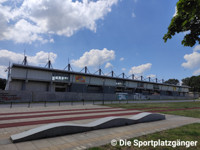
03.07.2021 © Die Sportplatzgänger 
03.07.2021 © Die Sportplatzgänger 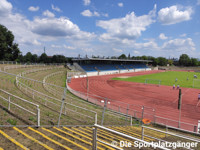
03.07.2021 © Die Sportplatzgänger 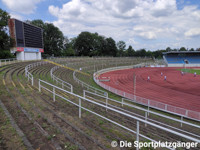
03.07.2021 © Die Sportplatzgänger 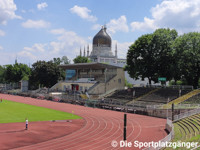
03.07.2021 © Die Sportplatzgänger 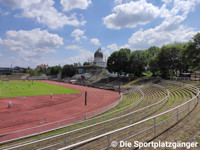
03.07.2021 © Die Sportplatzgänger 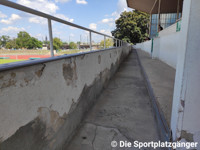
03.07.2021 © Die Sportplatzgänger 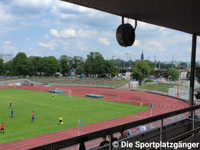
03.07.2021 © Die Sportplatzgänger 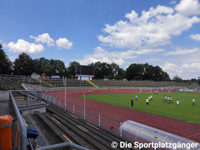
03.07.2021 © Die Sportplatzgänger 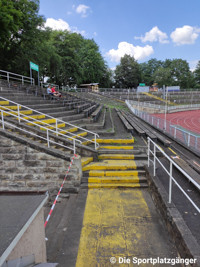
03.07.2021 © Die Sportplatzgänger 
03.07.2021 © Die Sportplatzgänger 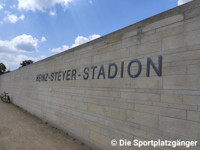
03.07.2021 © Die Sportplatzgänger
2020
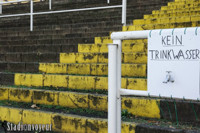
24.10.2020 © Stadionvoyeur 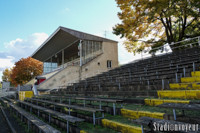
24.10.2020 © Stadionvoyeur 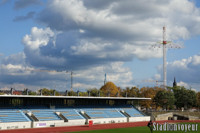
24.10.2020 © Stadionvoyeur 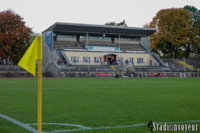
24.10.2020 © Stadionvoyeur 
24.10.2020 © Stadionvoyeur 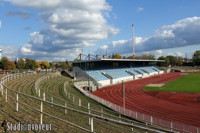
24.10.2020 © Stadionvoyeur 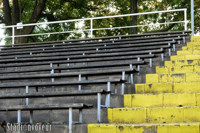
24.10.2020 © Stadionvoyeur 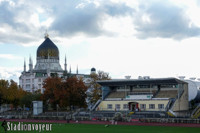
24.10.2020 © Stadionvoyeur 
24.10.2020 © Stadionvoyeur 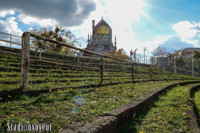
24.10.2020 © Stadionvoyeur 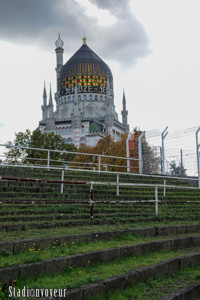
24.10.2020 © Stadionvoyeur 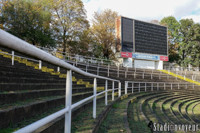
24.10.2020 © Stadionvoyeur 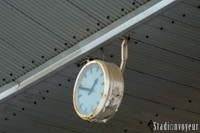
24.10.2020 © Stadionvoyeur 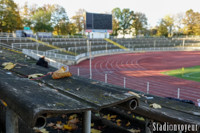
24.10.2020 © Stadionvoyeur 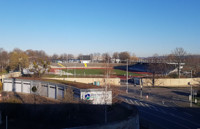
01.04.2020 © Stadiony.net 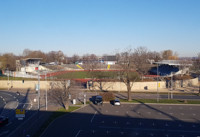
01.04.2020 © Stadiony.net
2017

23.08.2017 © SchiDD (CC BY-SA 4.0)
2011
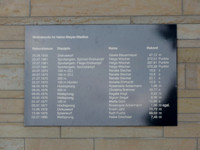
21.05.2011 © Ykaphrykoi CC BY-SA 2.1 JP
2007
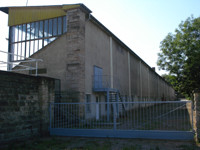
15.07.2007 © Kay Körner (CC BY 2.5) 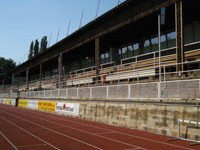
15.07.2007 © Kay Körner (CC BY 2.5) 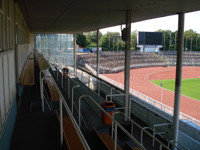
15.07.2007 © Kay Körner (CC BY 2.5) 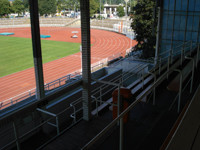
15.07.2007 © Kay Körner (CC BY 2.5) 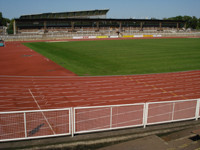
15.07.2007 © Kay Körner (CC BY 2.5) 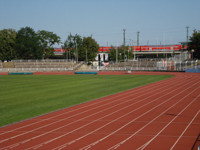
15.07.2007 © Kay Körner (CC BY 2.5) 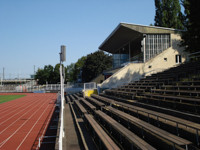
15.07.2007 © Kay Körner (CC BY 2.5) 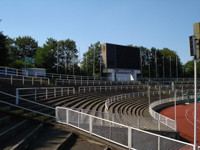
15.07.2007 © Kay Körner (CC BY 2.5) 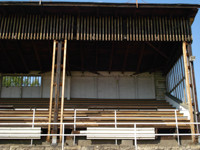
15.07.2007 © Kay Körner (CC BY 2.5) 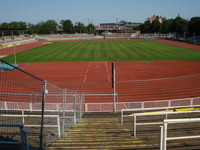
15.07.2007 © Kay Körner (CC BY 2.5) 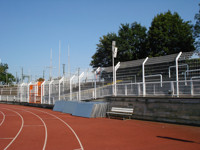
15.07.2007 © Kay Körner (CC BY 2.5) 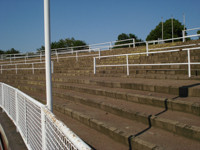
15.07.2007 © Kay Körner (CC BY 2.5) 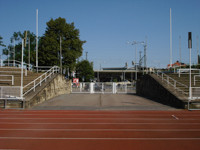
15.07.2007 © Kay Körner (CC BY 2.5) 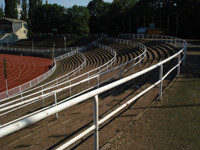
15.07.2007 © Kay Körner (CC BY 2.5) 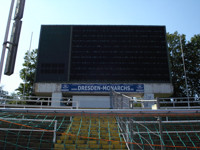
15.07.2007 © Kay Körner (CC BY 2.5)
2003
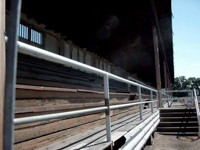
06.09.2003 © Frank Jasperneite 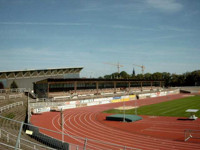
06.09.2003 © Frank Jasperneite 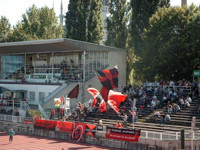
06.09.2003 © Frank Jasperneite

 StadiumDB
StadiumDB